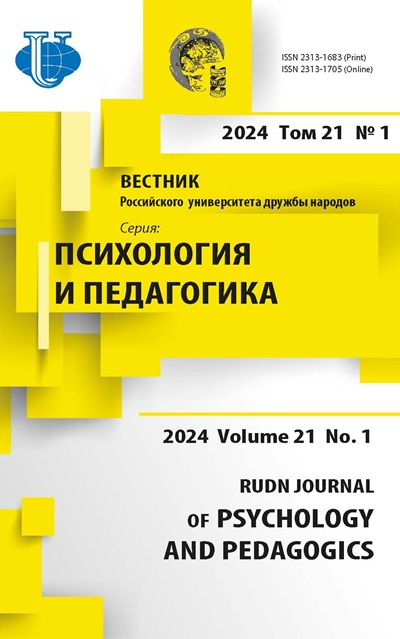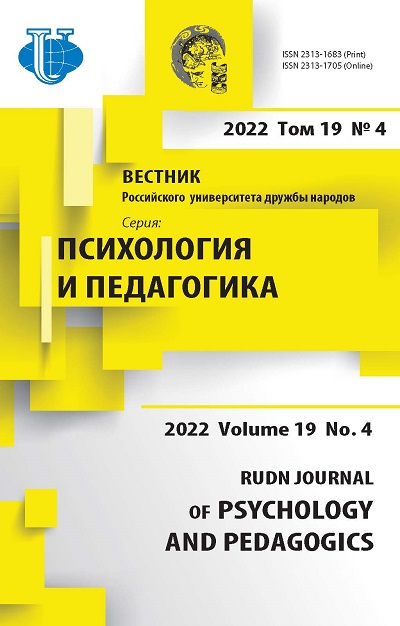Distortions of Body Perception during Immersion in Computer Virtual Reality Using Full-Body Tracking
- Authors: Varlamov A.V.1, Yakovleva N.V.1
-
Affiliations:
- Ryazan State Medical University named after Academician I.P. Pavlov
- Issue: Vol 19, No 4 (2022)
- Pages: 670-688
- Section: PERSONALITY IN THE DIGITAL AGE: KNOWLEDGE, EDUCATION, DEVELOPMENT
- URL: https://journals.rudn.ru/psychology-pedagogics/article/view/33144
- DOI: https://doi.org/10.22363/2313-1683-2022-19-4-670-688
Cite item
Full Text
Abstract
Person’s immersion in computer virtual reality (VR) is accompanied by numerous distortions in his/her perception due to the replacement of sensory stimuli coming through visual, auditory and partially proprioceptive channels. In this case, the person’s own body becomes an immersion tool, since its movements indirectly affect the movement of the avatar in VR. Performing actions in VR on behalf of the avatar contributes to the appearance of distortions in the perception of one’s own body due to the diffuse effect of actualizing the operational image at the moment of purposeful activity (the subjective body image is modified in accordance with the need to adapt to VR conditions). There are various ways of immersing in VR, taking into account the different degree of involvement of individual parts of the recipient’s real body in controlling a digital character. Thus, the full-body tracking (FBT) technology is becoming widespread, allowing the use of almost all human gross motor skills for projection onto the movements of the avatar. The purpose of the study was to establish the specific features of the distortion of a person’s perception of the size of his/her own body, after its being immersed in computer virtual reality, and the control over the avatar using the FBT technology. The study was conducted in two stages (in 2020 and 2021) in order to compare the intensity and direction of body image distortions of the subjects when they were immersed with and without the FBT technology. The OhShape VR app for mobile immersion without FBT and a modification of the VR Chat app for mobile immersion with FBT were used as experimental exposures. Psychometric data on the subjects’ perception of their own bodies were obtained using the psychometric data on the subjects’ perception of their own bodies were obtained using Moshe Feldenkrais’ methods for physical measurements. According to the results of the study, the use of FBT during immersion in VR leads to distortions in the perception of various body sizes by the subjects, including the trunk and legs, while mobile immersion without the use of FBT only causes distortions in the perception of the dimensions of the upper shoulder girdle. It should be noted that this observation testifies to the connection of distortions with the facts of the involvement of the corresponding parts of the real body of the subjects in the process of controlling the avatar. It is concluded that there are specific distortions in the perception of a person’s own body when being immersed in VR using FBT. Finally, an assumption is made about the possible connection of these distortions with the success of performing intra-environment mobile tasks.
Keywords
About the authors
Andrey V. Varlamov
Ryazan State Medical University named after Academician I.P. Pavlov
Author for correspondence.
Email: andrey.varlamov.62@gmail.com
ORCID iD: 0000-0002-6144-6036
Specialist of the Center for Practical Psychology
9 Vysokovoltnaya St, Ryazan, 390026, Russian FederationNatalya V. Yakovleva
Ryazan State Medical University named after Academician I.P. Pavlov
Email: yakovleva.nata2@gmail.com
ORCID iD: 0000-0002-7682-7245
PhD in Psychology, Associate Professor, is Head of the Department of General and Special Psychology with a Course in Pedagogy
9 Vysokovoltnaya St, Ryazan, 390026, Russian FederationReferences
- Bordnick, P.S., Carter, B.L., & Traylor, A.C. (2011). What virtual reality research in addictions can tell us about the future of obesity assessment and treatment. Journal of Diabetes Science and Technology, 5(2), 265–271. https://doi.org/10.1177/193229681100500210
- Clus, D., Larsen, M.E., Lemey, C., & Berrouiguet, S. (2018). The use of virtual reality in patients with eating disorders: Systematic review. Journal of Medical Internet Research, 20(4). https://doi.org/10.2196/jmir.7898
- Corno, G., Serino, S., Cipresso, P., Baños, R.M., & Riva, G. (2018). Assessing the relationship between attitudinal and perceptual component of body image disturbance using virtual reality. Cyberpsychology, Behavior, and Social Networking, 21(11), 679–686. https://doi.org/10.1089/cyber.2018.0340
- Feldenkrais, M. (2001). Awareness through movement: Health exercises for personal growth. Moscow: Institut Obshchegumanitarnykh Issledovanii Publ. (In Russ)
- Felnhofer, A., Kothgassner, O.D., Schmidt, M., Heinzle, A.-K., Beutl, L., Hlavacs, H., & Kryspin-Exner, I. (2015). Is virtual reality emotionally arousing? Investigating five emotion inducing virtual park scenarios. International Journal of Human-Computer Studies, 82, 48–56. https://doi.org/10.1016/j.ijhcs.2015.05.004
- Ferrer-Garcia, M., Gutiérrez-Maldonado, J., & Riva, G. (2013). Virtual reality based treatments in eating disorders and obesity: A review. Journal of Contemporary Psychotherapy, 43(4), 207–221. https://doi.org/10.1007/s10879-013-9240-1
- Fonseca-Baeza, S., Corno, G., & Baños, R.M. (2018). An intervention protocol proposal to modify the body image disturbance using Virtual Reality. Calidad De Vida Y Salud, 11(2), 48–61.
- Freeman, D., Reeve, S., Robinson, A., Ehlers, A., Clark, D., Spanlang, B., & Slater, M. (2017). Virtual reality in the assessment, understanding, and treatment of mental health disorders. Psychological Medicine, 47(14), 2393–2400. https://doi.org/10.1017/s003329171700040x
- Irvine, K.R., Irvine, A.R., Maalin, N., McCarty, K., Cornelissen, K.K., Tovée, M.J., & Cornelissen, P.L. (2020). Using immersive virtual reality to modify body image. Body Image, 33, 232–243. https://doi.org/10.1016/j.bodyim.2020.03.007
- Lashkova, E.D., Chaplinа, K.V., & Varlamov, A.V. (2020). Body image in virtual reality: Mobile actions in the VR environment and distortions in the perception of the size of your own body. Psychology and Medicine: Ways to Search for Optimal Interaction: Conference Proceedings (pp. 98–103). Ryazan: Ryazan State Medical University. (In Russ.)
- Liu, T., Pietschmann, D., & Ohler, P. (2022). Affecting explicit and implicit body image with thin-idealized avatars in virtual reality: The role of sense of embodiment. Cyberpsychology, Behavior, and Social Networking, 25(3), 174–180. https://doi.org/10.1089/cyber.2021.0091
- Maltseva, D.D. (2015). The role of operative image in the activity structure: main approaches in native psychology. Vestnik of Moscow State Linguistic University, (8), 161–169. (In Russ.)
- Monthuy-Blanc, J., Bouchard, S., Ouellet, M., Corno, G., Iceta, S., & Rousseau, M. (2020). “eLoriCorps Immersive Body Rating Scale:” Exploring the assessment of body image disturbances from allocentric and egocentric perspectives. Journal of Clinical Medicine, 9(9). https://doi.org/10.3390/jcm9092926
- Nosov, N.A. (2000). Virtual psychology. Moscow: Agraf Publ. (In Russ)
- Porras-Garcia, B., Serrano-Troncoso, E., Carulla-Roig, M., Soto-Usera, P., FerrerGarcia, M., Figueras-Puigderrajols, N., Yilmaz, L., Onur Sen, Y., Shojaeian, N., & Gutiérrez-Maldonado, J. (2020). Virtual reality body exposure therapy for anorexia nervosa. A case report with follow-up results. Frontiers in Psychology, 11, 956. https://doi.org/10.3389/fpsyg.2020.00956
- Riva, G., Bacchetta, M., Baruffi, M., & Molinari, E. (2001). Virtual reality-based multidimensional therapy for the treatment of body image disturbances in obesity: A controlled study. CyberPsychology & Behavior, 4(4), 511–526. https://doi.org/10.1089/109493101750527079
- Rubo, M., & Gamer, M. (2019). Visuo-tactile congruency influences the body schema during full body ownership illusion. Consciousness and Cognition, 73, 102758. https://doi.org/10.1016/j.concog.2019.05.006
- Shalyapin, А.A., & Danina, М.M. (2020). Studies of the effect of presence in virtual reality: Current status and perspective. Psychological Studies, 13(71), 6. (In Russ) https://doi.org/10.54359/ps.v13i71.191
- Soloveva, I.A. (2017). Who are we really? About the unconscious body image. Moscow: Izdatel' Bazenkov I.L. Publ. (In Russ.)
- Tack, C. (2021). Virtual reality and chronic low back pain. Disability and Rehabilitation: Assistive Technology, 16(6), 637–645. https://doi.org/10.1080/17483107.2019.1688399
- Van der Veer, A.H., Alsmith, A.J.T., Longo, M.R., Wong, H.Y., & Mohler, B.J. (2018). Where am I in virtual reality? PLoS ONE, 13(10). https://doi.org/10.1371/journal.pone.0204358
- Varlamov, A.V., & Yakovleva, N.V. (2021). Dynamics of perception distortions of human body physical dimensions in virtual reality. RUDN Journal of Psychology and Pedagogics, 18(1), 254–270. (In Russ.) https://doi.org/10.22363/2313-1683-2021-18-1-254-270
- Varlamov, A.V., & Yakovleva, N.V. (2021). Peculiarities of human perception of own body in virtual reality. Bulletin of the Moscow Region State University. Series: Psychology, (2), 21–31. (In Russ.) https://doi.org/10.18384/2310-7235-2021-2-21-31
- Yakovleva, N.V., & Varlamov, A.V. (2021) Distortions in a person’s body perception after performing dynamic tasks in virtual reality. RSUH/RGGU Bulletin. Psychology. Pedagogics. Education Series, (2), 130–146. (In Russ.) https://doi.org/10.28995/2073-6398-2021-2-130-146
- Zinchenko, Yu.P., Menshikova, G.Ya., Bayakovsky Yu.M., Chernorizov, A.M., & Voiskounsky, A.E. (2010). Virtual reality technology in the context of world and national psychology: Methodological aspects, achievements and prospects. National Psychological Journal, (1), 54–62. (In Russ.)
















